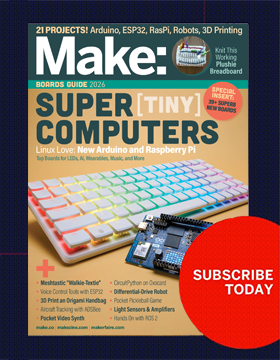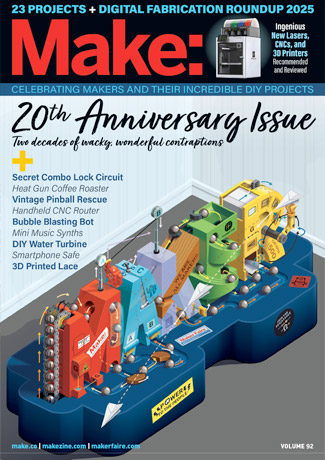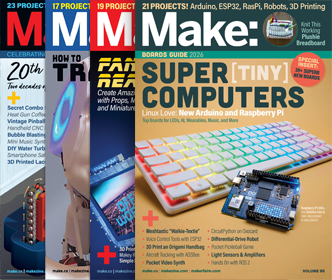

In the early 1960s, integrated circuit chips had military and aerospace applications such as the Minuteman missile. By the 1970s, the situation had changed radically: Ads in Popular Electronics offered individual 7400 quad 2-input NANDs for less than $1 each.
Now the question was — how could hobbyists use them?
In 1974 Don Lancaster’s TTL Cookbook told us how. It was an amazing repository of information that had been almost impossible to find, written by a man who worked for an aerospace contractor. Lancaster showed pinouts for almost a hundred chips using transistor-transistor logic (TTL), and then walked you through the process of combining them in circuits. When I first ran across it in a Radio Shack store, I felt stunned — disoriented — to have all this information in my hands. It was like the key to a world-changing secret society. (That’s my well-worn copy of the first edition shown above.)

I had never enjoyed analog projects such as audio amplifiers, requiring resistors and capacitors with values that had to be exactly calculated to preserve the subtle nuances of a signal. Lancaster told me that logic chips were not like that. The output from one chip went straight into the input of another, with no messing around.
His book required patience and concentration — he had a relentlessly factual style, which was not reader-friendly — but it taught me something profoundly important:
You can do this. It’s not as hard as you think.
For my first project, I decided to build electronic dice. The Cookbook included a dice circuit, but it used D-type flip-flops, which were hard to understand. With the arrogance of ignorance, I decided to create a simpler version. The circuit required some decoding logic to convert binary output from a counter chip into the spot patterns for two dice, and I had to figure out how to make each counter roll over after counting from binary 000 to binary 101. But it worked, and it still works, almost 50 years later.

Dawn of the keyboard
Don Lancaster was a quintessential maker, before that term existed. But beyond that, he was a true visionary, writing his book when personal computers did not yet exist. You couldn’t even buy a keyboard; they were only sold for serious money, for gadgets such as teletype machines. But Don foresaw the need for keyboards to control digital devices, and if we couldn’t buy them, we’d have to fabricate them ourselves. In February 1973, his article “Build Your Own Low-Cost Keyboards” appeared in Radio Electronics magazine.
This was not a trivial project. It listed a source for the plastic key caps, but everything else was up to you. Etching circuit boards in your garage was the easy part; you also had to make your own momentary switches. He suggested mounting a disc of carbon-urethane sponge on a plunger beneath each key, so that the sponge pressed against two contacts. Carbon particles in the sponge caused it to become more conductive as it was squashed. His engineering drawing of the key structure is reproduced below.

To protect the copper contacts from oxidation, “Gold, nickel, or tin plating is ideal,” he wrote, “but you can use ordinary silver-ink ‘PC Repair’ paint, provided you thin it properly and bake it on.” He recommended an oven at 200 degrees Fahrenheit.
Eventually Southwest Technical Products, widely known as SWTP, started selling a keyboard kit that was Don’s design, and they paid him royalties. But he had already gone further, developing the “TV Typewriter,” a video terminal which could be used with one of his keyboards to display two pages of 16 lines of 32 uppercase characters on a standard television set. This became his best-known project.

No one had ever made something which enabled you to type on a keyboard and see text on a TV screen. You couldn’t print the text, or save it, because there were no affordable printers or data storage devices. But the project established prerequisites for the personal computer revolution, which began 18 months later, when the Apple I was announced. Even then, keyboards were still difficult to obtain, so the Apple was sold without one, and a lot of buyers used Don’s SWTP kit to build their own. At the Computer History Museum in Mountain View, an Apple I has a Lancaster keyboard.
On his own path
So who was this radical innovator? In an autobiographical summary Don described himself as an “archetypical computer nerd.” He was physically small while growing up in Pittsburgh, and recalled being frequently “thrown into trash cans or belittled by gym teachers.” But by the time he graduated, he had become a radio ham and was building projects such as walkie-talkies, a theremin, and a Van de Graaff generator.
He published his first feature in Electronics World in 1963, which paid him $150. At the time, he saw this as “lots of money.”

To avoid being drafted into the military he took a job at Goodyear Aerospace, developing high-resolution CRT displays. In his spare time, he wrote for all the electronics magazines, describing fun devices such as a random audio tone generator, a color organ, color TV testers, and — yes — electronic dice. But after his TTL Cookbook became a best-seller, he became self-employed. According to Don, the book eventually sold more than 1 million copies.
The advent of the Web was a gift for him; he retrieved the rights to many of his books and made them into PDFs, using his own PostScript code to create the layouts. He gave away the PDFs on his website, which he named “The Guru’s Lair,” and he lived partly on income from banner ads.
Don once characterized himself as “leading the way but missing out on the longer term rewards.” This was true; he ended up writing software patches for Apple, which were implemented on the Apple IIe, instead of joining the other engineers in Silicon Valley. Evidently he preferred living in the Arizona desert with his wife and daughter.
Democratizing digital DIY
I never met Don Lancaster and I never will because, I was sad to learn, he died on June 7, 2023, aged 83. Still, his daughter Cathy is preserving his memory. She is maintaining “The Guru’s Lair,” which is a classic example of hand-coded HTML, as you can see from its homepage. The site is a huge, sprawling repository reflecting Don’s numerous interests, from PostScript programming to exploring the desert near the Gila River.

When I learned he had died, I contacted Cathy, who was kind enough to share some memories of her father. Always thrifty, Don used to get her to duplicate floppies for his software mail-order business, and paid her 10 cents per disk.
She said he wrote his books because “he realized that the normal person didn’t have access to the information. He wanted to make it so that anyone could sit down and build something using his book.” Which I did.
Cathy doesn’t have many of the devices that Don made, but she does still have his electronic dice, which of course preceded mine.

Before he died, her father wrote more than 40 books — including some that he self-published — on topics from Apple II assembly language to making enough money to survive as a self-employed person. But the message was always basically the same:
You can do this. It’s not as hard as you think.
- Cathy invites people who have memories of Don Lancaster to contact her via email at memoriesofdon@tinaja.com
- You can visit “The Guru’s Lair” at www.tinaja.com
- On YouTube you can find videos by a maker who built his own copy of the TV Typewriter using mostly period components:
Images by Charles Platt except as noted
This article appeared in Make: Vol. 89. Subscribe to support more maker projects and articles!
ADVERTISEMENT








